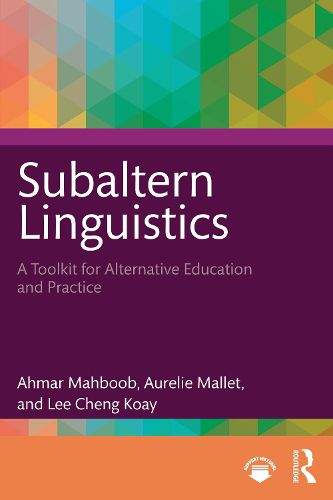Readings Newsletter
Become a Readings Member to make your shopping experience even easier.
Sign in or sign up for free!
You’re not far away from qualifying for FREE standard shipping within Australia
You’ve qualified for FREE standard shipping within Australia
The cart is loading…






Subaltern Linguistics challenges the goals and theoretical foundations of colonial linguistics, academia, and education and provides alternative approaches and practices. The goal of subaltern practice is to create economies, projects, and resources that can be made and used by community members and leaders to develop and promote community beneficial projects in their own language (or a language of their choice). In doing subaltern and CREDIBLE work, we need to develop a new array of tools and resources. This book provides a broad introduction for how this can be done along with examples of multiple CREDIBLE projects carried out by students and members of the broader community.
The textbook is divided into four parts. In Part I, we establish the need for this work, introduce some concepts that the CREDIBLE approach draws on, and explain what we mean by CREDIBLE projects. In Part II, we share what can be done when we adopt a CREDIBLE approach, including several examples of student projects across a range of areas such as education, environment, healthcare and economic development. Part III provides detailed guidelines and instructions on how to develop CREDIBLE projects with worksheets and activities that can be used to conceptualise, plan, and develop CREDIBLE projects. Finally, Part IV includes four CREDIBLE project reports as examples of how this work can be written up for wider dissemination.
This text is an essential guide to a new way of doing linguistics, reflecting the diversity and richness of today's world.
$9.00 standard shipping within Australia
FREE standard shipping within Australia for orders over $100.00
Express & International shipping calculated at checkout
Subaltern Linguistics challenges the goals and theoretical foundations of colonial linguistics, academia, and education and provides alternative approaches and practices. The goal of subaltern practice is to create economies, projects, and resources that can be made and used by community members and leaders to develop and promote community beneficial projects in their own language (or a language of their choice). In doing subaltern and CREDIBLE work, we need to develop a new array of tools and resources. This book provides a broad introduction for how this can be done along with examples of multiple CREDIBLE projects carried out by students and members of the broader community.
The textbook is divided into four parts. In Part I, we establish the need for this work, introduce some concepts that the CREDIBLE approach draws on, and explain what we mean by CREDIBLE projects. In Part II, we share what can be done when we adopt a CREDIBLE approach, including several examples of student projects across a range of areas such as education, environment, healthcare and economic development. Part III provides detailed guidelines and instructions on how to develop CREDIBLE projects with worksheets and activities that can be used to conceptualise, plan, and develop CREDIBLE projects. Finally, Part IV includes four CREDIBLE project reports as examples of how this work can be written up for wider dissemination.
This text is an essential guide to a new way of doing linguistics, reflecting the diversity and richness of today's world.